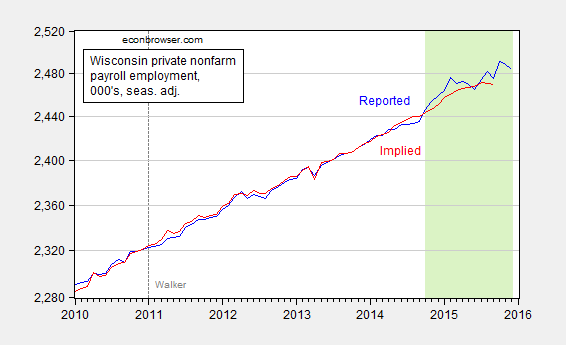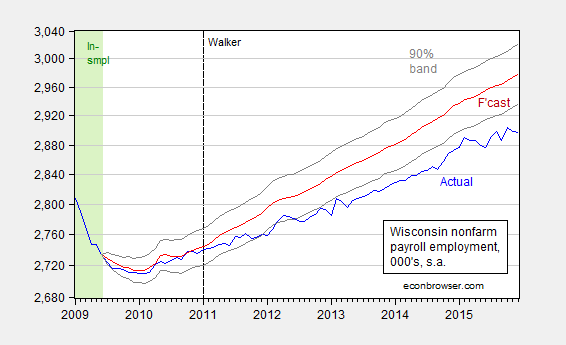Not so certain the slowdown will be similarly erased.
Toward the end of 2014 through early 2015, Wisconsin private nonfarm payroll employment surged, as measured by the establishment survey. The just released data associated with the Quarterly Census of Employment and Wages (QCEW) [1] suggests that when the benchmarked state-level establishment series are released on Monday, that surge will be erased.
The blue line in Figure 1 depicts the reported BLS series as of today. The green shaded area denotes the period over which QCEW data will be used to benchmark the establishment series.
Figure 1: Wisconsin private nonfarm payroll employment as reported (blue), and as predicted using Quarterly Census of Employment and Wages private nonfarm payroll employment (red), in 000’s, seasonally adjusted. Source: BLS and author’s calculations.
The red line is the establishment series predicted using the QCEW series (after seasonal adjustment using ARIMA X12) over the 2001M01-2014M09 period. (For details on the procedure, see this post). Note that the red line is substantially below the blue over the 2014M10-2015M09 period.
This means that the 12 month change will be 1.25%, rather than 1.61%, in the period ending 2015M09. Moreover, the plateau-ing of employment shows up in mid-2015, rather than end-2015.
I would compare the implied current levels against the forecasts from the Wisconsin Economic Outlook, which is apparently supposed to be released quarterly (not so in recent years). Unfortunately, the last available Economic Outlook is from May 2015, nearly ten months ago. Using that measure, we can how the Wisconsin economy has underperformed relative to Walker Administration forecasts.
Figure 2: Wisconsin private nonfarm payroll employment as as predicted using Quarterly Census of Employment and Wages private nonfarm payroll employment (red), and forecast from May 2015 Wisconsin Economic Outlook (black), in 000’s, seasonally adjusted. Source: BLS, Wisconsin Economic Outlook (May 2015) and author’s calculations.
However, we can compare employment (as reported) against what should have occurred if historical correlations obtained (see this post):
Figure 3: Wisconsin nonfarm payroll employment (blue), forecast from error correction model estimated over 1990M03-2009M06 (red), and 90% confidence band (gray lines), all on log scale. Dashed line at 2011M01 when Walker takes office, and light green denotes sample period. Source: BLS, author’s estimates (as described here).
Note that even using the optimistic pre-benchmark series, Wisconsin private nonfarm payroll employment remains 87,700 below the 250,000 additional new jobs target for January 2015 that Governor Walker committed to in August 2013.
Update, 3/15: The level of private NFP was revised upward back to the beginning of 2014. I show the growth of employment relative to 2014M09.
Figure 4: Wisconsin private nonfarm payroll employment, December 2015 release (blue), and January 2016 release (red), relative to 2014M09, in 000’s, seasonally adjusted. Source: BLS and author’s calculations.




I am looking at January 2012 in the bottom graph: what policies had Walker not only passed but also had time to implement that would have caused the extremely wide divergence between the blue line and the red line?
The further away from 2011 we get the more plausible it is that this is Walker’s fault, but it looks like a lot of the disconnect occurred even before his policies had time to take effect.
By the way, the most libertarian state in the U.S., Colorado (based on TABOR, its low tax rate and higher-than-average acceptance of drug use), is doing extremely well!
Anonymous: Given the nature of your comment, my guess, you weren’t living in Wisconsin in early 2011. Here is a start, as discussed in this post. By the way, if you are a believer that economic policy uncertainty depressess investment and hiring in a quantitatively important way (something many conservatives have asserted in the past seven years), then you might think of non-fiscal measures that had an impact on economic activity.
I was a State of WI worker during that period. I saw what was coming and curtailed my spending drastically. No more vacationing up north or eating out. Tens of thousands of others did the same. The “savings” by Walker’s policies went to rich people who either lived out of state or spent their extra money out of state, creating a net negative economic result for Wisconsin. To those of us on the ground who talk to regular folks every day this is obvious.
“suggests that when the benchmarked state-level establishment series are released on Monday, that surge will be erased.”
Update?
Anonymous aka Asian with 4.0 and a perfect SAT rejected by Harvard aka Anonymous aka Future President Donald Trump aka Scott Walker, American Patriot and Freedom Fighter aka BUT THE MODELS SHOW US!! aka (xo poa) aka YOLO! aka JS aka Joe: See added figure 4.